You may not find this terribly rewarding unless you're included here, so this is a good time for casual and random browsers to turn back before they get too caught up in the sweep and majesty of the proceedings and can't let go.
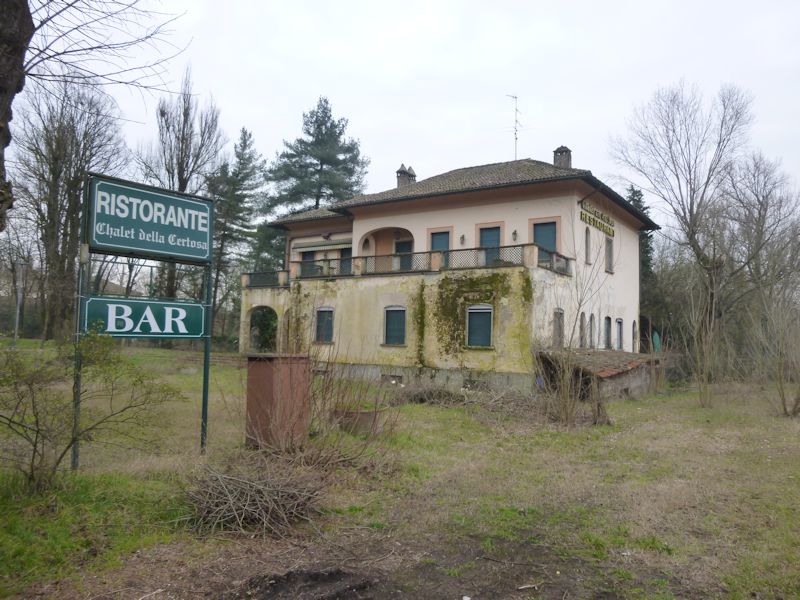
We spent yesterday gallivanting in Pavia, and now we're back to visit the famous Certosa di Pavia. That depressing wreck is not the Certosa, but it sort of guards the front gates. Or used to.

Here's the front of the Certosa when we glanced in on it two days ago -- on a bright and sunny afternoon, 25 February.
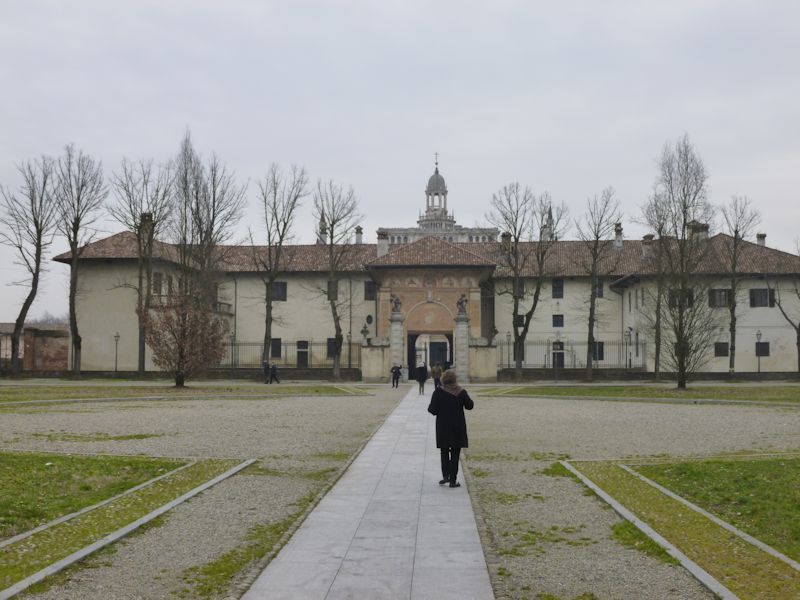
Humpff. Bleak, chilly -- a nearly colorless 27 February 2015. A Certosa (or Chartreuse in French, Charterhouse in English) is a monastic complex of the Carthusian order of cloistered monks, founded by St Bruno in 1044. Not sure why.
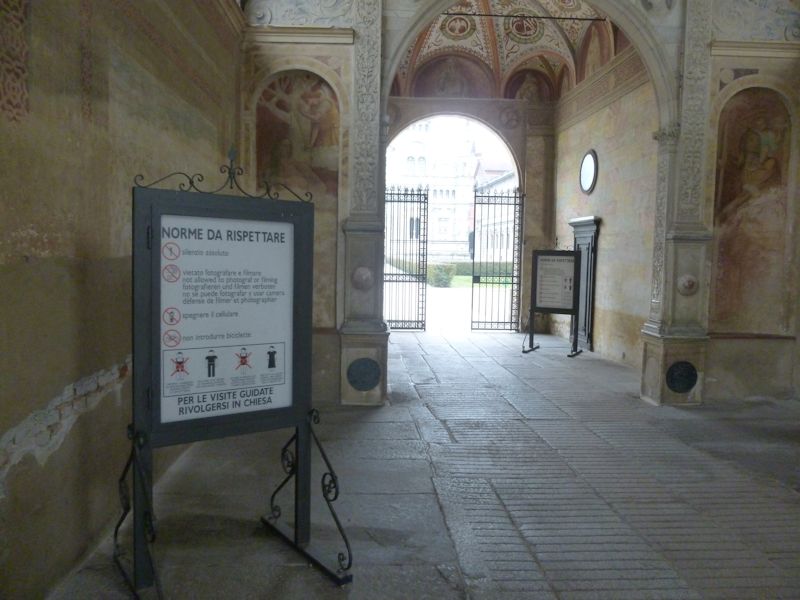
Welcome!! It recalls the Stations of the Cross; we're meant to reflect deeply upon each of these sets of rules and regulations as we process into the interiors.
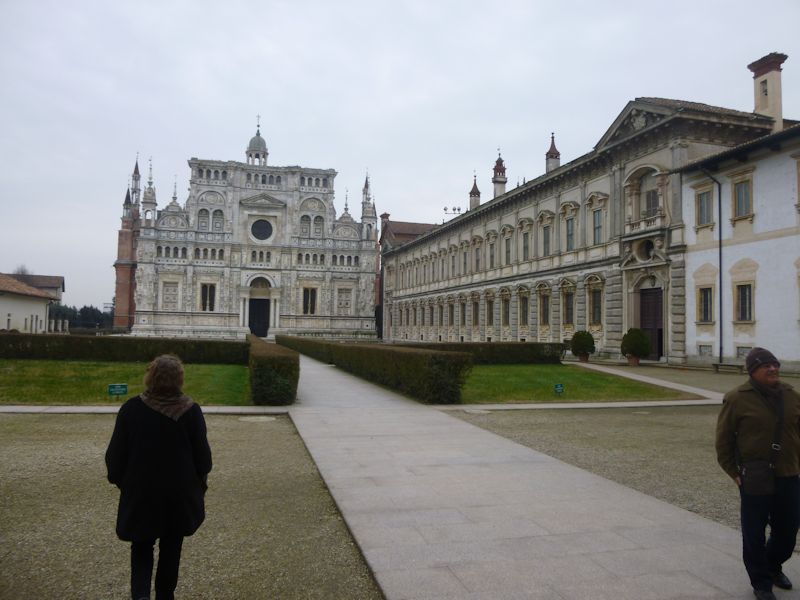
The church in all its decorative glory, with the 17th century Ducal Palace along the right side of the garden. The monastic complex, 8km north of Pavia town, was commissioned in 1396 by Gian Galeazzo Visconti, who'd been created the first Duke of Milan in 1395 with a huge bribe to the King of the Romans and King of Bohemia, Wenceslaus the Idle.

Gian Galeazzo, when he signed all the contracts and laid the foundation stone, was hoping for an architectural attraction worthy of serving as the Visconti family mausoleum. The monastic infrastructure got priority, however, and the worthy Duke died in 1402 in any case, so the church was evidently on the back-burner for a while: the Gothic nave was completed in 1465, but after a series of chief architects each with his own ideas and styles inherited the dossier, the church wasn't consecrated until 1497, and the façade was not finished off until 1507.
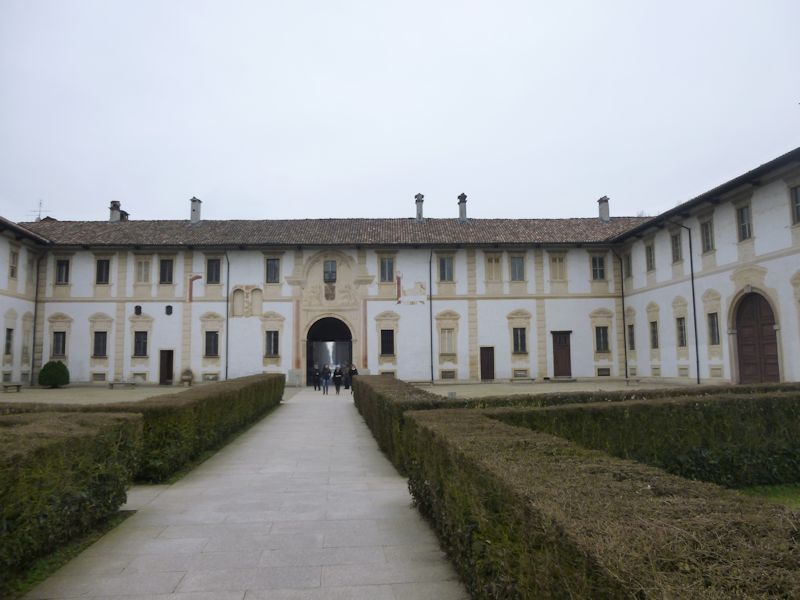
The front gate from the inside. The Carthusians were thrown out by the Austrian overlords in the 1780s and the Certosa was taken over by a bunch of Cistercians in 1784. It was shut down in 1810 but reoccupied by Carthusians in 1843. The new Italian state adopted it as a national monument, however, in 1866, and only agreed to let some Cistercian monks back in in the 1960s. None of whom we've seen so far today.
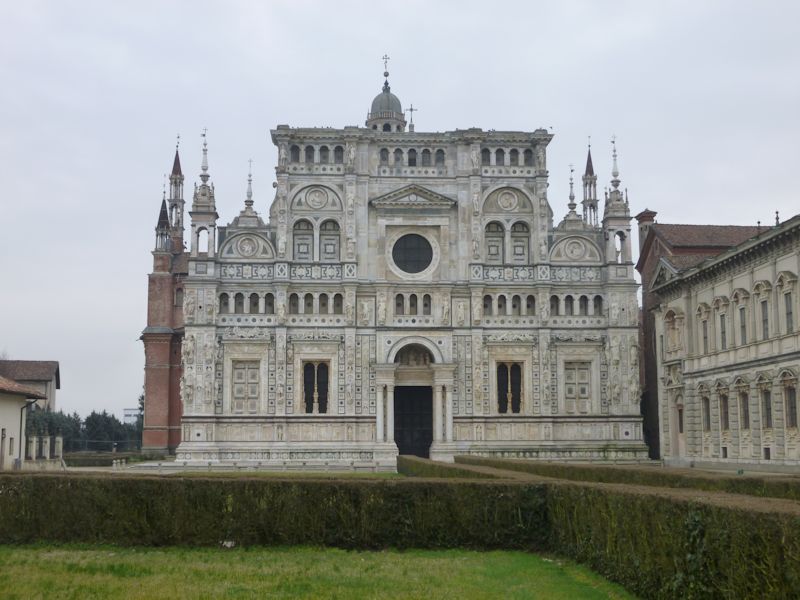
From a distance, this complicated mess seems symmetrical but still crazy, but we'll need to get closer to really, really appreciate it.
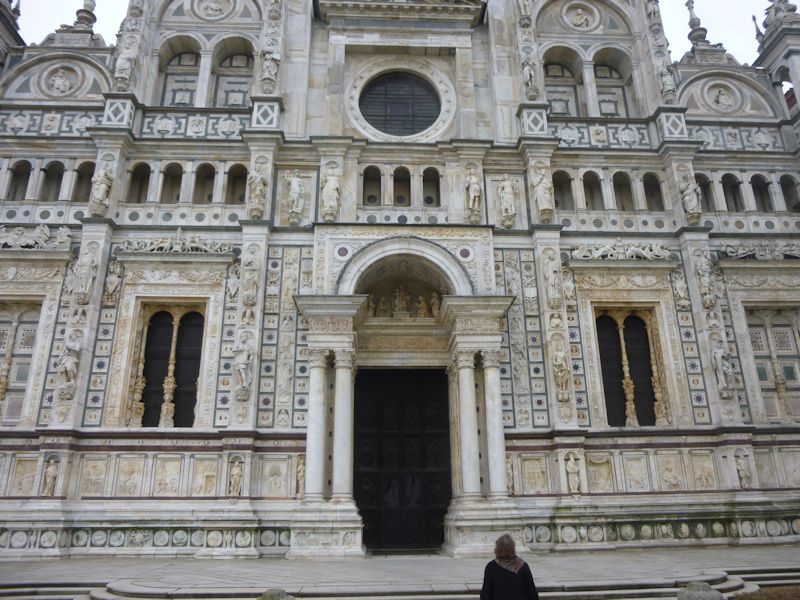
Kristin is awed. Where do we start? How about the front porch with its Corinthian columns!
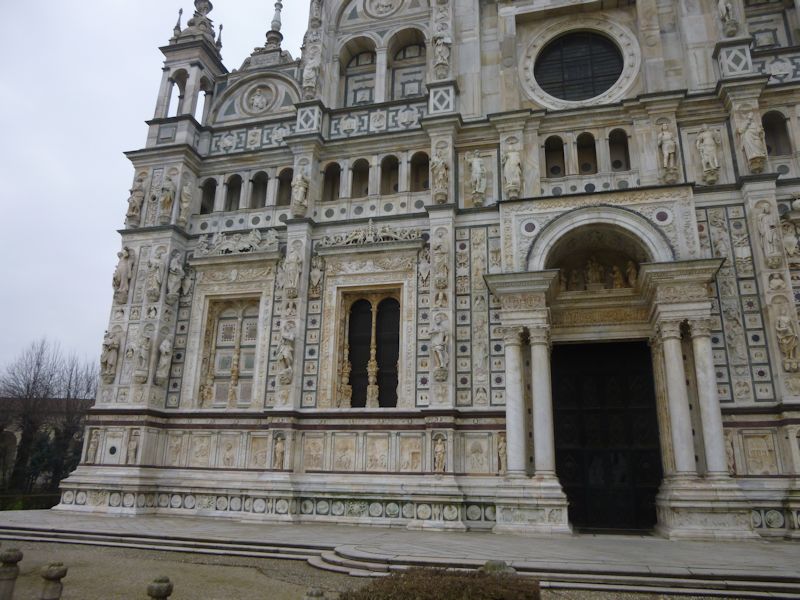
How frustrating must it have been for journeymen sculptors working on all these saints and biblical scenes high up on the beautiful façade, chipping away in the knowledge that, once they'd finished and the scaffolding had come down, no one would be able to see what they'd achieved without powerful binoculars, ever.
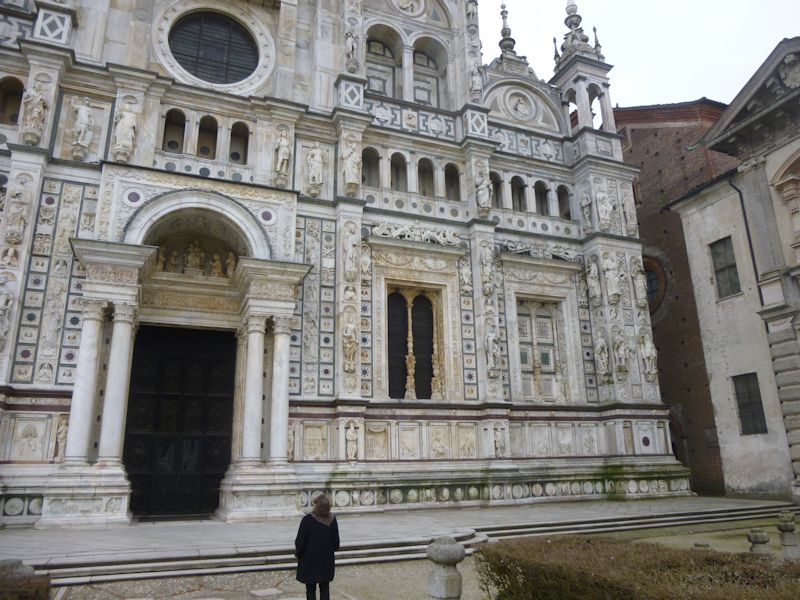
The overall impression is, well, impressive, but . . .

. . . maybe a little zoom lens will help.
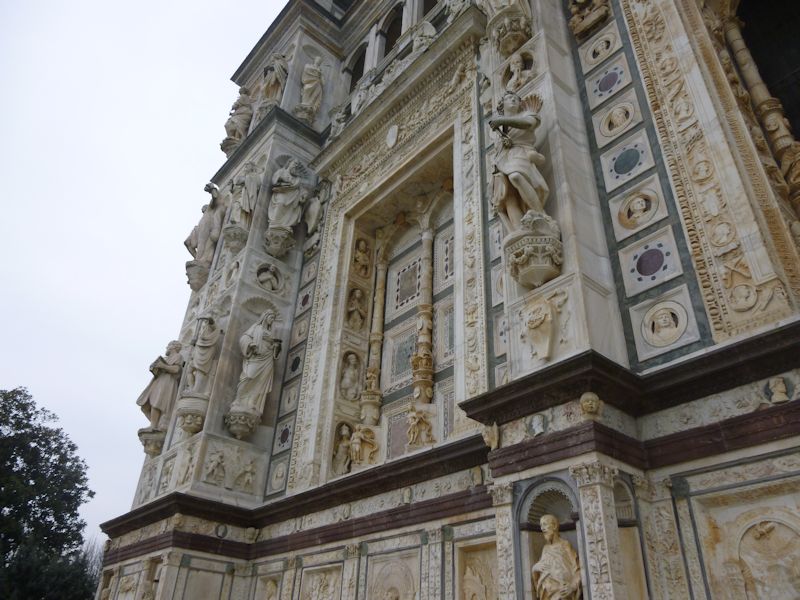
It's all very, very complicated, and . . .

. . . it's almost a relief to peek round behind the curtains and see that the body of the church is built of the usual Lombard brickwork.
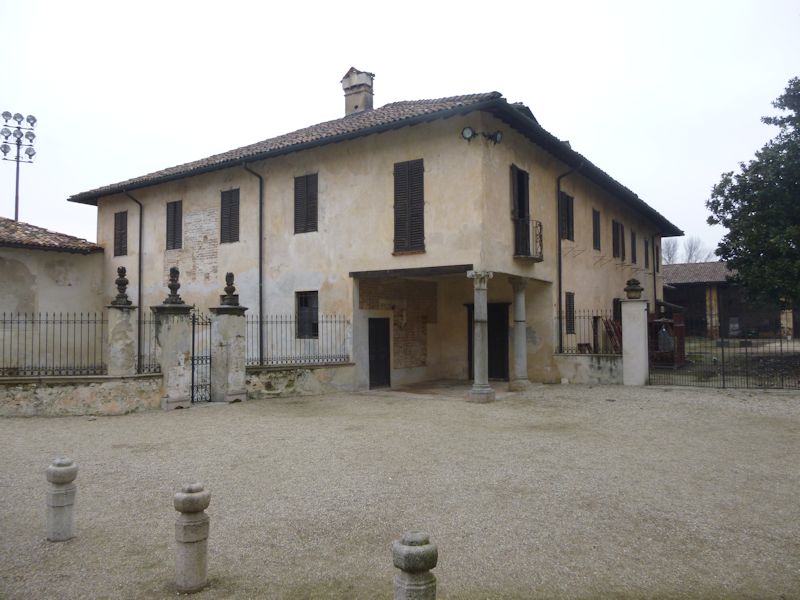
A much simpler façade next door; it's probably where the monks keep their rakes, hoes, and pruning shears.

The courtyard in front of the church; the ducal palace on the left, with the unpleasant gift shop at the end of that.
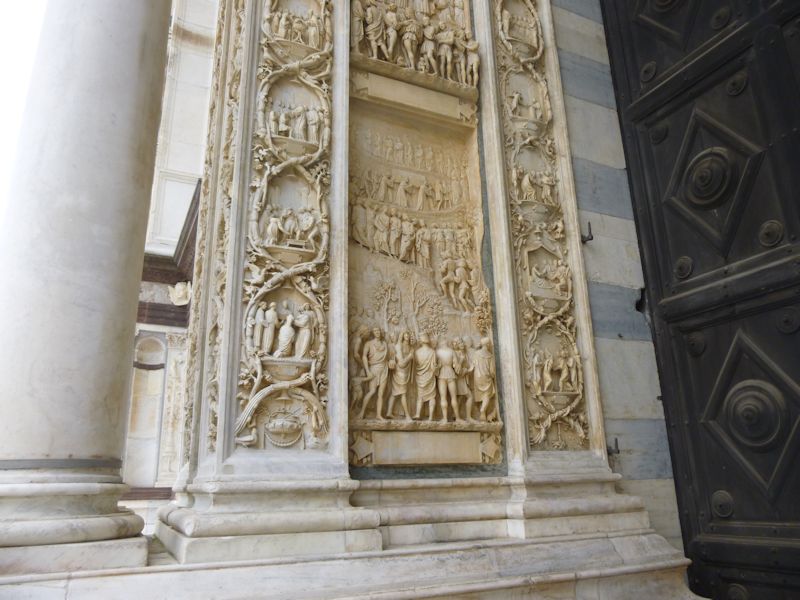
A little more detail beside the front door; episodes from the history of the monastery . . .

. . . and, in fact, that looks a lot like Duke Gian Galeazzo Visconti laying the foundation stone.

Oh a convenient reminder. We'd already forgotten all those rules and regulations we memorized back at the last checkpoint. There are several good reasons for forbidding flash photography (e.g., blasts of photons bulleting right through those delicate ancient pigments, disturbing the old people praying in the pews, etc.), but only one reason for forbidding all photography -- postcard sales.
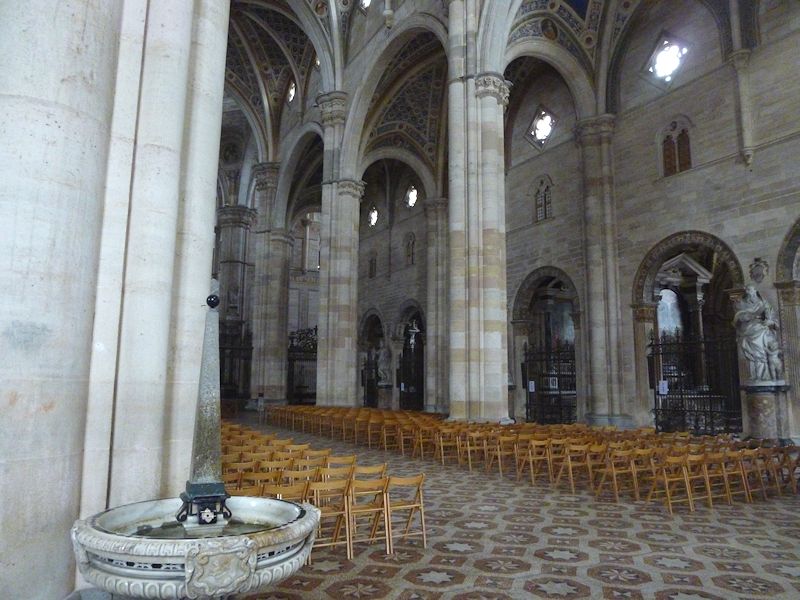
My own feeling is that the Pope doesn't really need my postcard revenues, all things considered, and secondly, if I've paid good money to visit a tourist attraction I should be permitted to prompt my memory in future years if any with a few photographic memorabilia -- Senza Flash, of course, as appropriate. (That's sort of why this photo was taken from behind the pillar as the photo-nazi was making his rounds at the other end of the nave.) [Disclosure: there was no entry fee, it's all gratuit.]
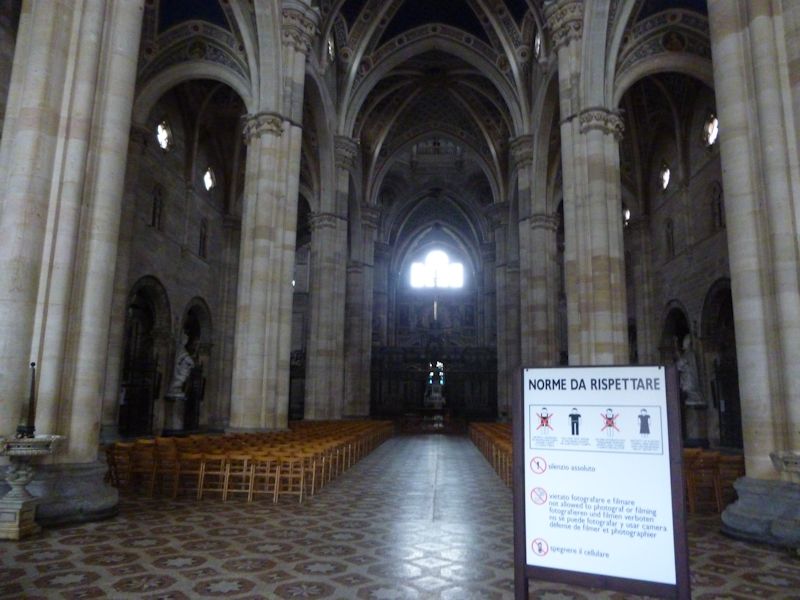
Okay, he's stalking someone else for the moment. The church is not huge but it's laid out on a classic Latin cross, with a central nave and two aisles, crossed by a transept at the far end, with a fairly elaborate apse end tacked onto it.
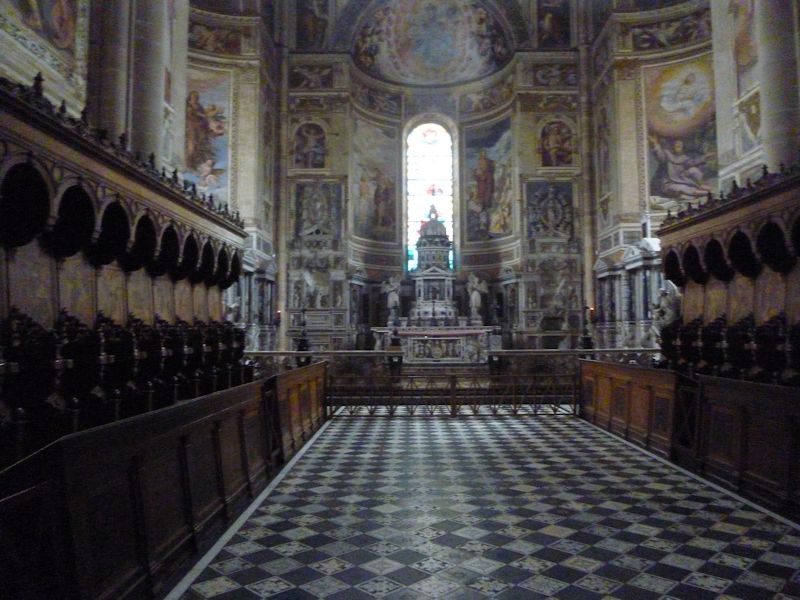
We've slipped into the choir and overstated altar area; this photo's being shot from a hole in my shirt pocket.

The high altar: this didn't come out too bad, though the NO PHOTOS warning sign on the right isn't really legible.
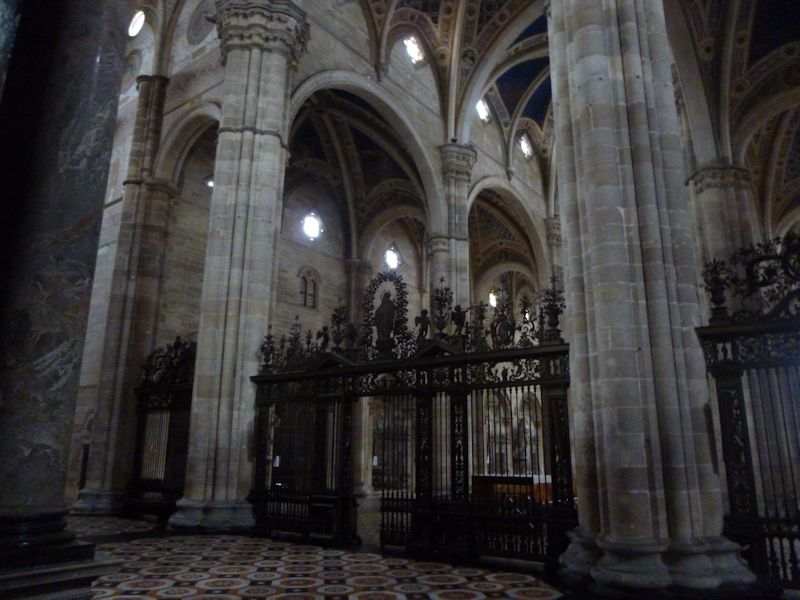
An odd sort of prison gate between the nave and the transept
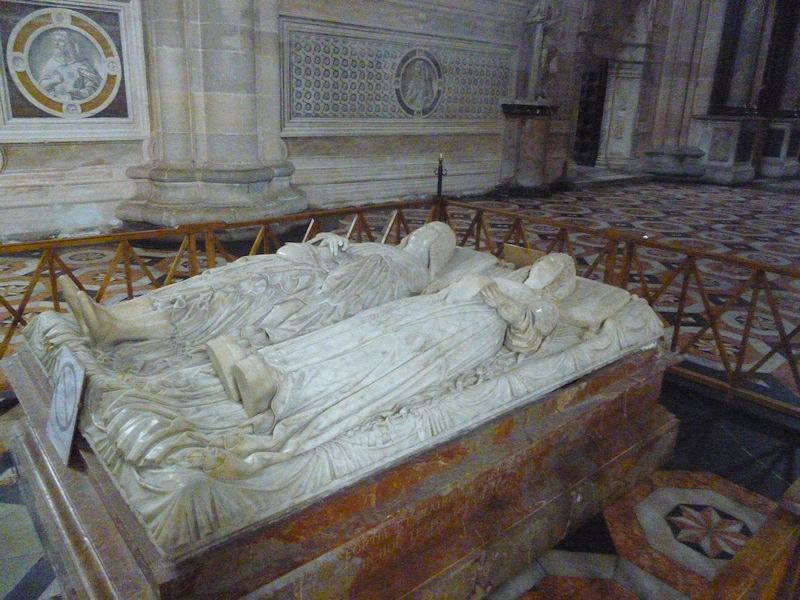
Here's one of the highlights we were looking for: in the northern transept (whilst Kristin is helpfully distracting the guard), the funerary monument of Ludovico 'il Moro' Sforza, Duke of Milan in the next dynasty, and his vivacious but apparently quite short wife Beatrice d'Este from Ferrara (who, famous for her learning and patronage of the greatest artists of the age, died in childbirth at 21). (A Swiss footnote: Ludovico was imprisoned by the French, 1500 until his death in 1508, after Swiss mercenary soldiers on both sides at the siege of Novara agreed that they didn't want to fight against one another and just went home.)
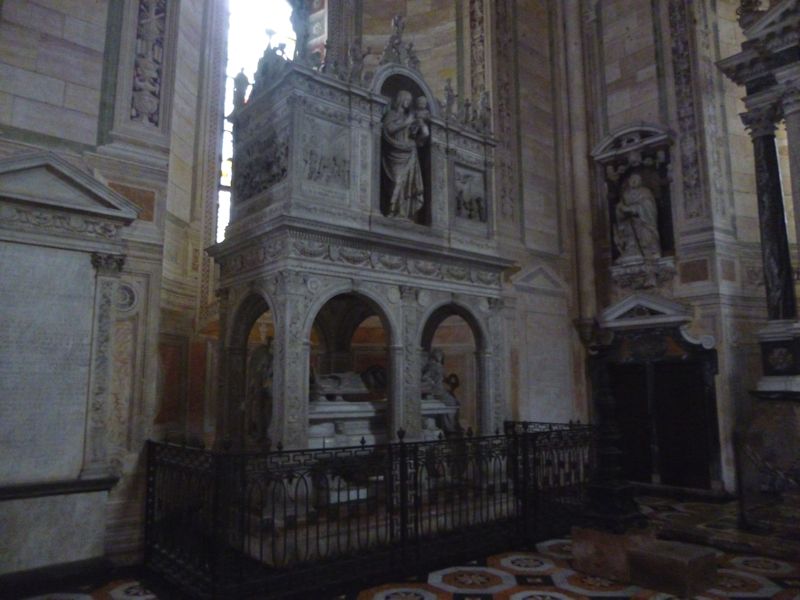
The other high point: here, tucked away at the southern end of the transept, is the enviable mausoleum (by Cristoforo Romano) of the man who made it all happen, Gian Galeazzo Visconti himself and his wife Isabella of Valois, Countess of Vertu, daughter of the hapless French king Jean II and Bonne of Bohemia, who was daughter of King John the Blind of Bohemia. Isabella was married at 12 and died in childbirth (after 4 children) at 24.
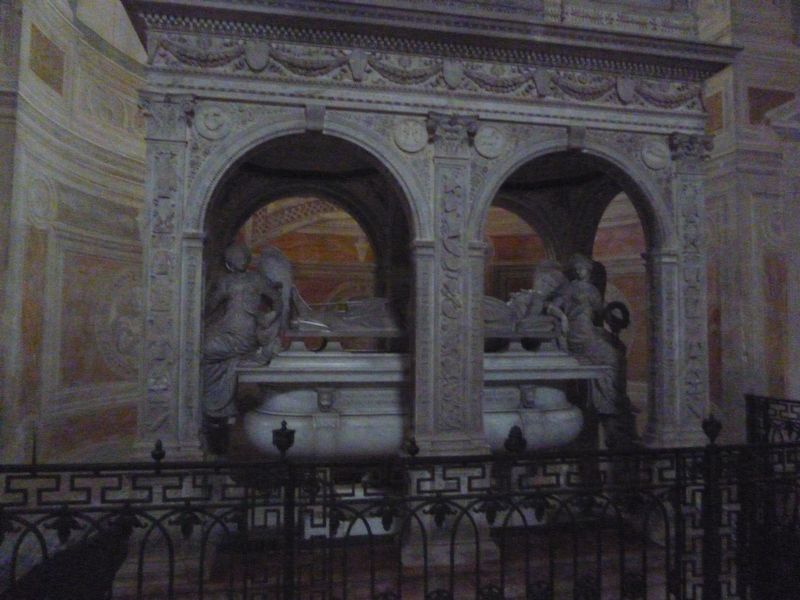
Gian Galeazzo and Isabella of Vertu, resting, hopefully in peace
(A footnote: the Bohemian king John the Blind [who was never accepted by the Bohemians] is an interesting example of something or other; thoroughly imbued with the knightly and chivalric virtues, but completely blind for the past decade, at the battle of Crécy against the English in 1346 he talked his bodyguard into conveying him into the centre of the battle: they tied all their horses' reins together to his and led him in to 'strike his stroke', and all of them were killed. His badge and motto ['I serve'] were adopted by the victorious Black Prince and are still part of the badge of the Prince of Wales.) (We might call it 'suicide by cop'.)
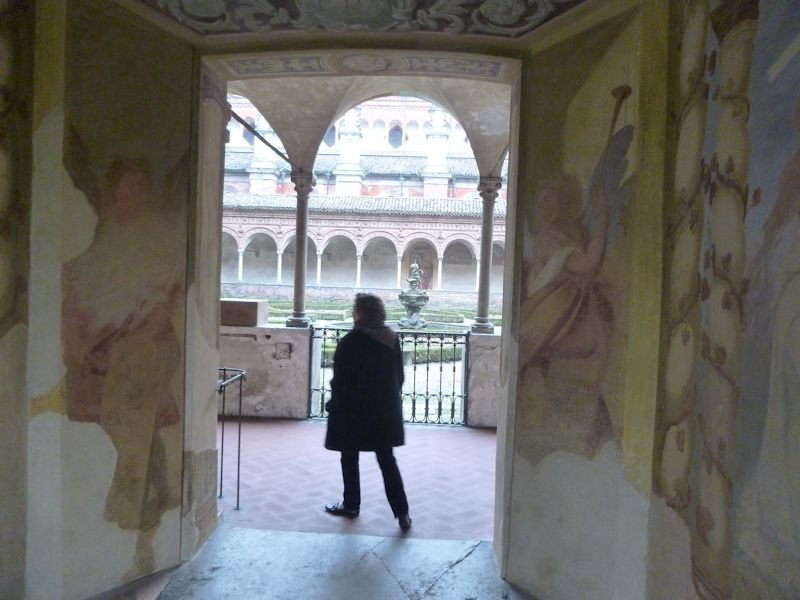
Kristin, tiring of viewing Gian Galeazzo's tomb, passes out into the Small Cloister.

Out the back door, the Small Cloister; try to imagine it on a sunny summer day, with all the flowers in bloom or whatever.
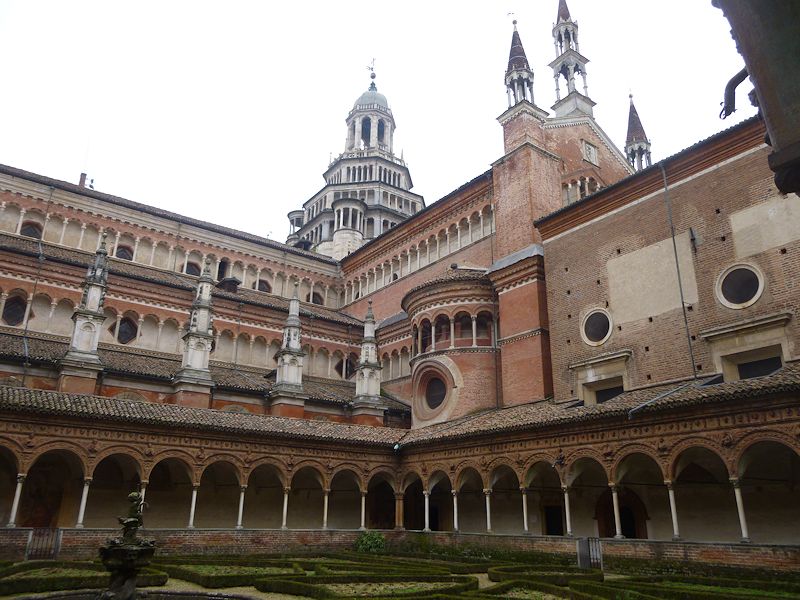
From the Small Cloister
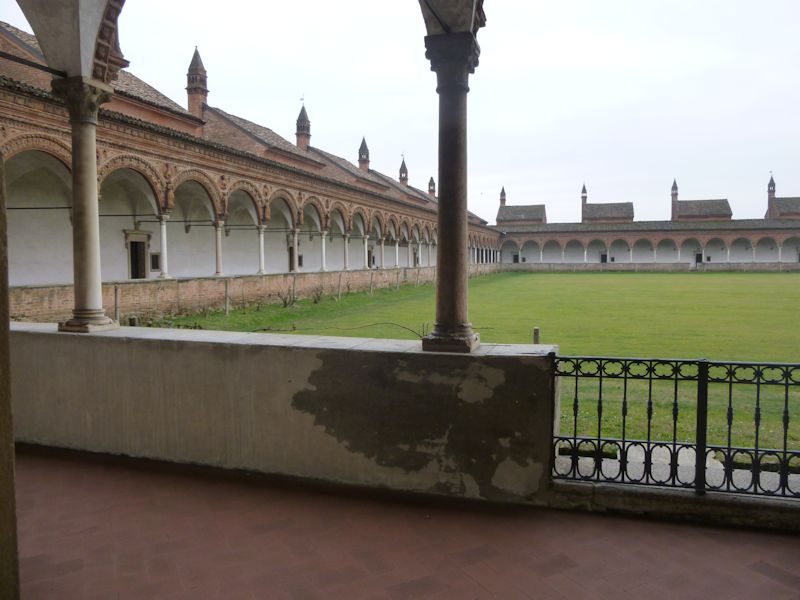
And this on the other hand is the Grand Cloister, with all the comfy homes of the monks ringing it round. Each cute little bungalow has a salon and chapel, a tiny garden attached, and bedroom upstairs, and a slot in the door so that food can be passed in without any words spoken, which might spoil the charm or spell.
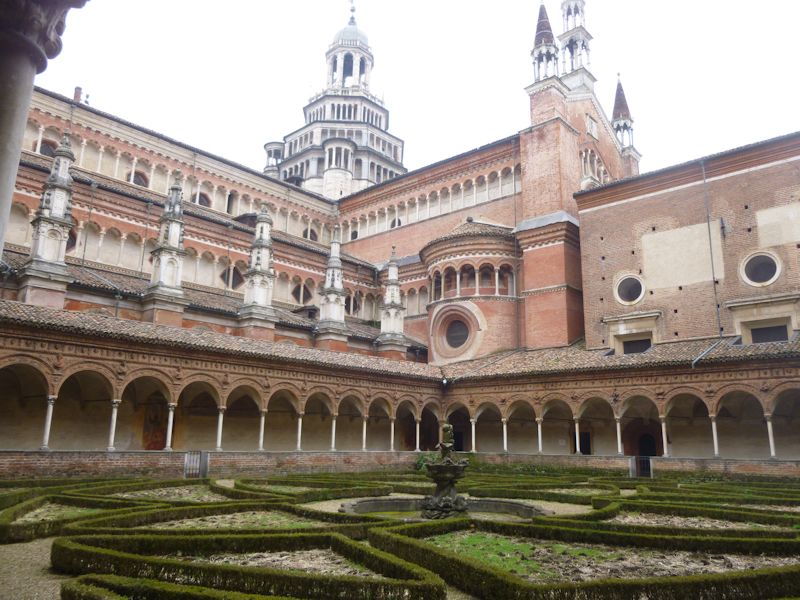
Back through the Small Cloister . . .

. . . and past Gian Galeazzo and his lady Isabella . . .
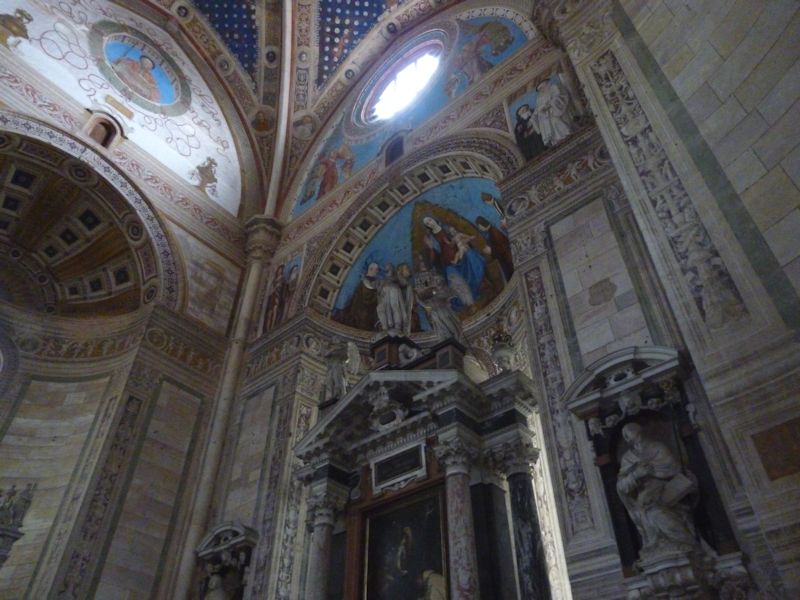
. . . and some additional shots I can get out of my shirt pocket whilst the earnest gentleman is following someone else intently.

There's probably a depressing story there but I don't know it. No Photos!
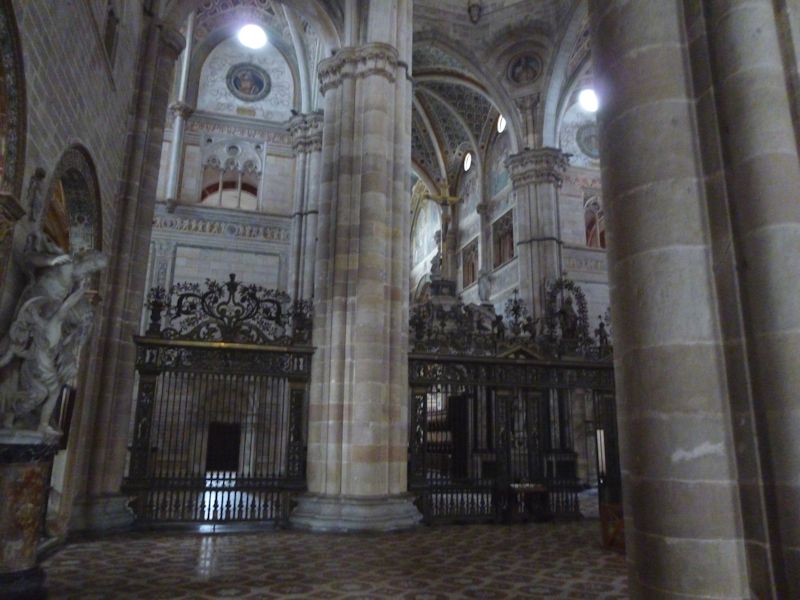
From the left aisle of the nave, looking at the caged checkpoint towards the presbytery and altar in the apse. (He's just round the other side of the pillar; might hear the camera click.)
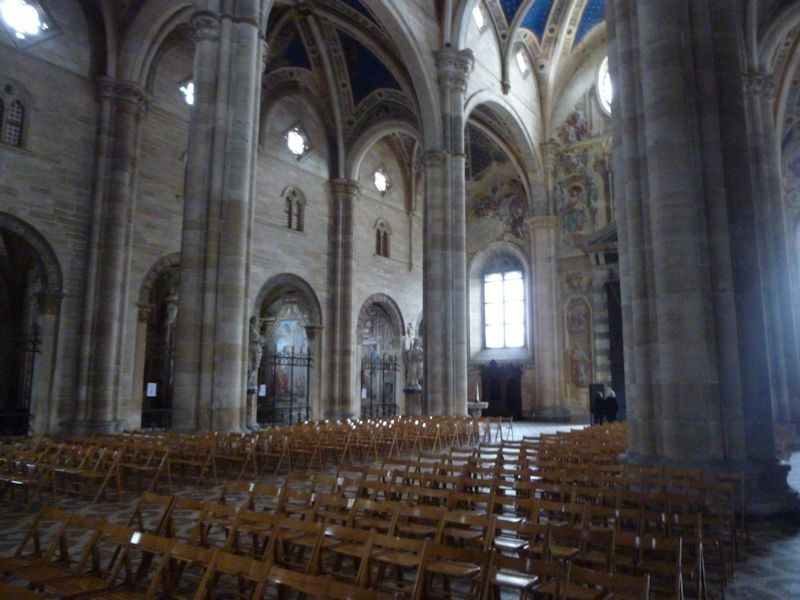
The nave, with all the chairs lined up so that parishioners can stare at the iron gates secure in the knowledge that there must be something going on up in the altar area.
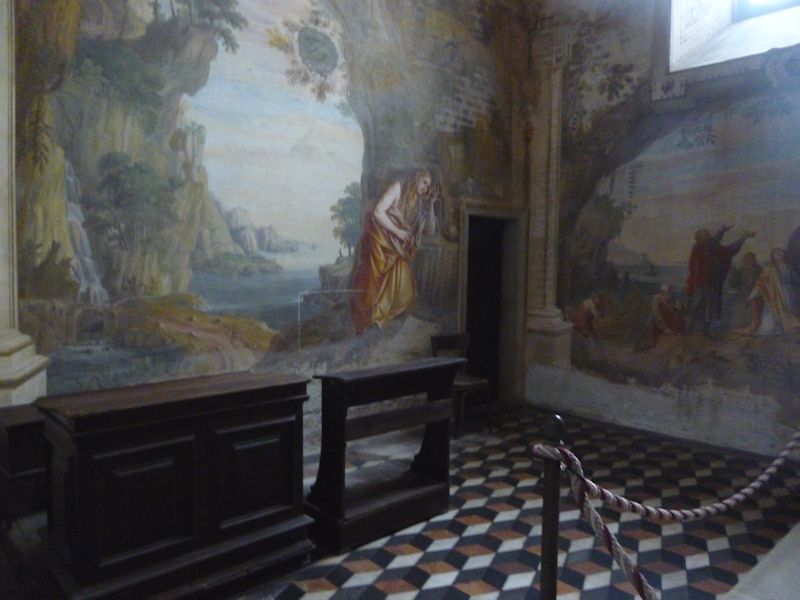
I wish I could have got closer; that looks like a Penitent Magdalene, pictures of whom I collect.
But in any case, with Kristin's diversionary help, I won't really need any copyrighted postcards to jog my memory, so it's all been worth the price after all. And, in any case, it was free admission.
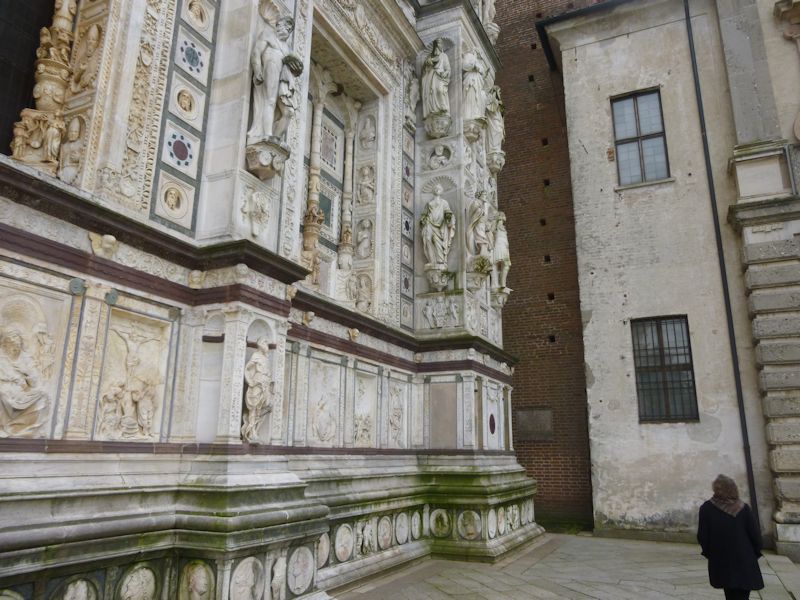
Back outside, we're addictively still trying to identify the various saints, Visconti relatives, cathedral donors, etc., but with no luck.
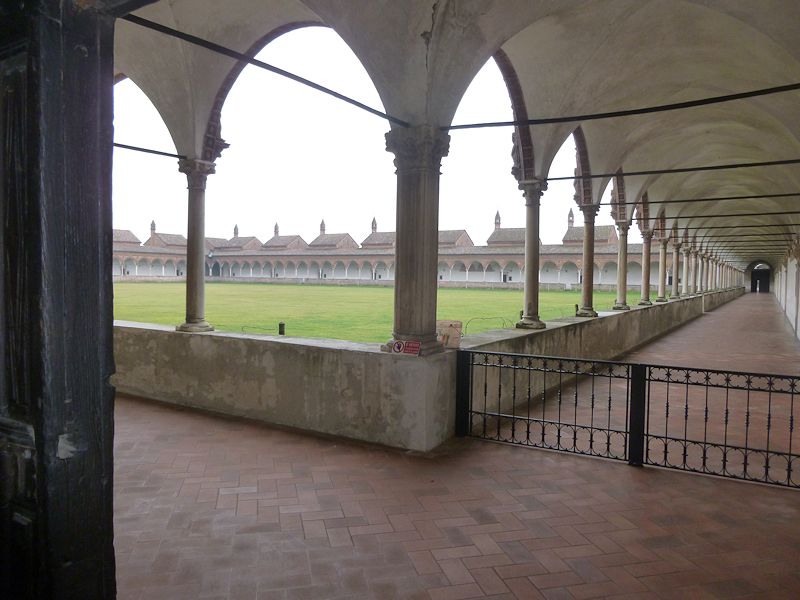
A peek again at the monks' bungalows, wishing them well until their next talk day, when they can relax and discuss the news of the world hastily amongst themselves.
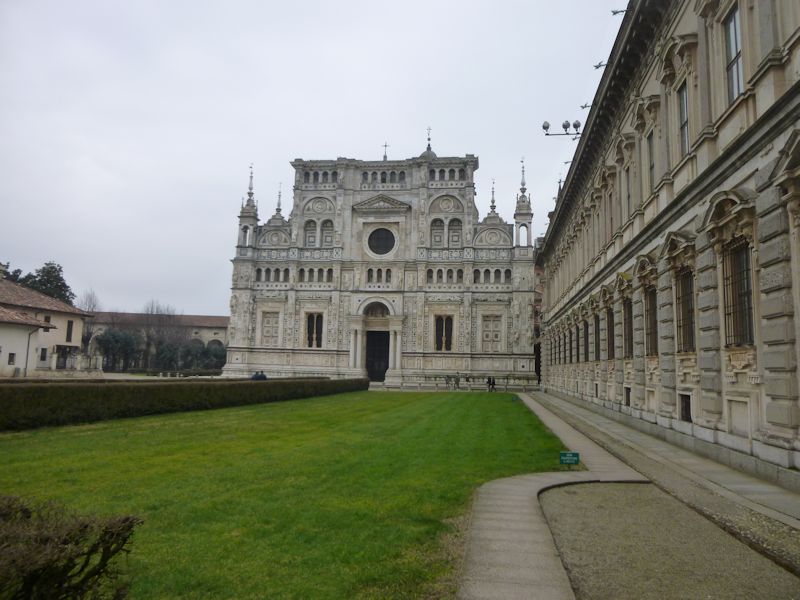
Kristin's in the gift shop, whilst I'm out here doing my anger management exercises. The monk at the desk and the janitor jovially conversing with him from the doorway, oblivious to people trying to pass through, both of them bitterly angry when politely requested to be allowed to enter or leave -- that's MY problem, they are what they are. A group of schoolgirls came in and asked directions, and were taken aback at the sales-monk's impatiently rude reply (he might have been much more accommodating if they'd been schoolboys).
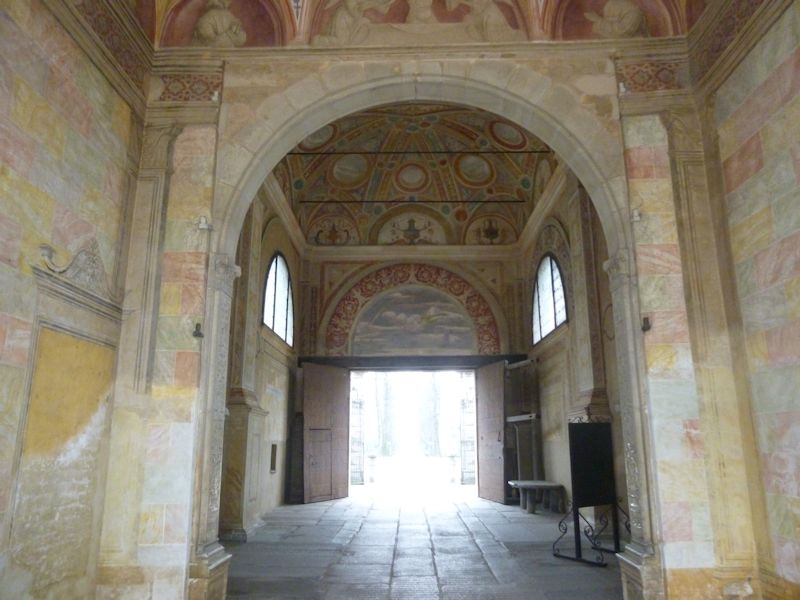
That was the only actual real-live Monk we actually saw, and it was not encouraging. The janitor, for all his oblivous bulk in the doorway, was not a monk, maybe a 'lay brother' or something. The photo-nazi was probably just trying to make a living, and was fairly perfunctory in performing his tasks. So, on balance, we've seen the old monastery but not learnt much about monasteries. And most of the good art stuff was out of my visual range.

But, at the end of the day (actually, at mid-morning, we've got a three-hour trip to Arezzo ahead of us), the Certosa di Pavia left me with a rather creepy feeling. Just LOOK at the thing. Who NEEDS all that? Was anybody in charge? Or did each generation just say "We've got another grant, go hire all the sculptors and painters you can find, and turn them loose. It's use it or lose it."
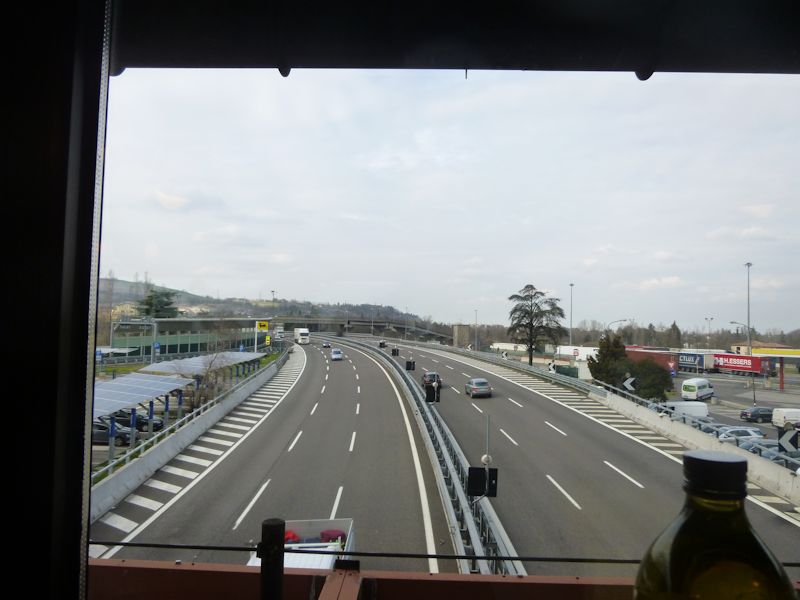
On the road. A restorative lunch at the Autogrill restoroute overlooking the autostrada from Bologna south past Florence to exit at Arezzo.

And at last, we're struggling to follow the Volvo SatNav machine down to our destination.
 Dwight Peck's personal website
Dwight Peck's personal website



























































